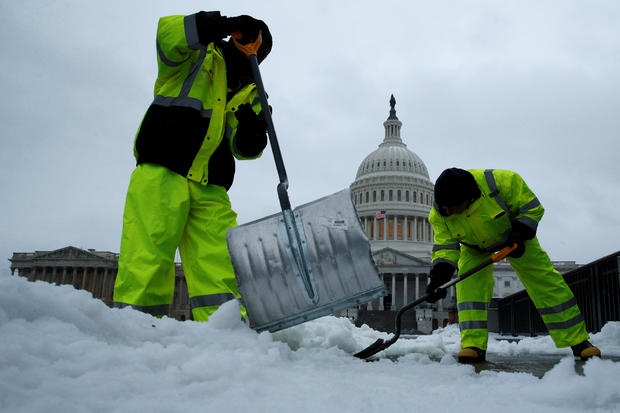Winter storm could chill an already weak economic growth forecast
Count the U.S. economy among the victims of the blizzard of ‘17.
The snowstorm that blanketed large parts of the Northeast could reduce the nation’s gross domestic product this quarter by as much as 0.2 percent, according to Oxford Economics, a global forecasting company. That would bring first-quarter growth to just 0.9 percent, by their analysis.
It may seem unlikely that a single storm, however large, could ding the entire economic output of a country. But the storm that hit the northeast U.S. Tuesday benefited from a confluence of factors that increased its impact, said Gregory Daco, Oxford’s head of U.S. economics: its size, its location and the fact that it happened on Tuesday.
“If storms hit in the middle of the week, their [economic] impact tends to be bigger, especially if one hits in the early morning,” he said. “Cleanup efforts generally last the entire day, so it’s a full day that’s gone for business owners or construction workers.”
A restaurant that closes for the day loses those customers and won’t be able to make up for it later by serving more, Daco said. For retail and manufacturing businesses, that lost income is not recoverable. Moreover, the snow is expected to linger for several days, meaning its dampening effects could be prolonged.
The snow fell heaviest in a band from eastern Pennsylvania through Massachusetts, a region that accounts for considerable economic activity. The densely populated region contributes a disproportionate amount to GDP, so when it is affected the impact on the economy is sizable, according to Daco.
In Maryland, Virginia, New Jersey and New York, more than 200,000 households are without power. Public schools in Boston and Scranton, Pennsylvania, planned to close for a second day Wednesday after the storm dropped over two feet of snow on some parts of the region. Airlines have cancelled 6,100 flights into and out of the U.S. as of Tuesday afternoon, according to flight-tracking website FlightAware.
Of course, many people are involved in preparing for a storm and cleaning up afterward -- activity that keeps the GDP hit from being deeper. Consider shoppers stocking up on groceries on Tuesday, road crews spreading salt before the snowfall and cleanup work that continues for several days.
Some effects of the storm likely won’t be seen for a few weeks. Because it hit during the second week of March, the storm could make for a slightly more disappointing jobs report come April, said Jim O’Sullivan, chief U.S. economist with High Frequency Economics.
The U.S. Department of Labor collects data on the second week of every month that it uses to compile a picture of how many jobs are created that month. The closely watched report is then released on the first Friday of the month that follows.
“You can find big snowstorms in the Northeast having a big impact on the employment data,” O’Sullivan said. He added that the last few jobs reports have been unexpectedly strong, possibly because January and February were warmer than usual.
O’Sullivan cautioned that it’s still too early to tell what effects the storm will have on the economy. Less than half of the data that is used to calculate the nation’s gross output for the first three months of year has been collected, he estimated. But for the last few years, first-quarter growth has been below expectations -- and blamed, more often than not, on chilly temperatures.




